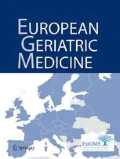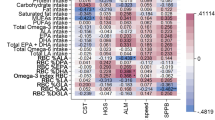Abstract
Purpose
To investigate associations between dietary protein and vitamin intake and physical function status in older adults with sarcopenia.
Methods
Data of 707 participants with sarcopenia aged > 60 years from the National Health and Nutrition Examination Survey (NHANES) 1999–2004 were analyzed. Body composition, body mass index (BMI), physical function status, demographics, dietary intake (protein and vitamins A, C, E), lifestyle factors and comorbidities were measured, stratified by gender.
Results
Dietary levels of carbohydrate, fat and vitamin E differed significantly between genders (P < 0.05). Physical function limitations (48.5 vs. 36%; P < 0.001), basic activities of daily living (ADL) limitations (37 vs. 24.4%; P < 0.001), and instrumental ADL limitations (25.6 vs. 17.8%) were higher in women than in men. Multivariate logistic regression analysis revealed that, in males, intake of optimal amounts of vitamin C (Q3: ≥ 60.71 mg/day) was associated with basic ADL limitations. In females, protein intake of more than 1.11 g/kg/day was associated with both basic and instrumental ADL limitations.
Conclusions
Only dietary or supplemental intake of vitamin C and E, but not protein, was associated with physical functioning in older males with sarcopenia. In contrast, only intake of higher amounts of protein, but not vitamins, was associated with physical functioning in older females with sarcopenia.
Similar content being viewed by others
References
Cruz-Jentoft AJ, Baeyens JP, Bauer JM, Boirie Y, Cederholm T, Landi F, Martin FC, Michel JP, Rolland Y, Schneider SM, Topinková E, Vandewoude M, Zamboni M, European Working Group on Sarcopenia in Older People (2010) Sarcopenia: European consensus on definition and diagnosis: report of the European Working Group on Sarcopenia in Older People. Age Ageing 39:412–423
Studenski SA, Peters KW, Alley DE, Cawthon PM, McLean RR, Harris TB, Ferrucci L, Guralnik JM, Fragala MS, Kenny AM, Kiel DP, Kritchevsky SB, Shardell MD, Dam TT, Vassileva MT (2014) The FNIH sarcopenia project: rationale, study description, conference recommendations, and final estimates. J Gerontol A Biol Sci Med Sci 69:547–558
Landi F, Cherubini A, Cesari M, Calvani R, Tosato M, Sisto A, Martone AM, Bernabei R, Marzetti E (2016) Sarcopenia and frailty: from theoretical approach into clinical practice. Eur Geriatr Med 7:197–200
Fielding RA, Vellas B, Evans WJ, Bhasin S, Morley JE, Newman AB, Abellan van Kan G, Andrieu S, Bauer J, Breuille D, Cederholm T, Chandler J, De Meynard C, Donini L, Harris T, Kannt A, Keime Guibert F, Onder G, Papanicolaou D, Rolland Y, Rooks D, Sieber C, Souhami E, Verlaan S, Zamboni M (2011) Sarcopenia: an undiagnosed condition in older adults. Current consensus definition: prevalence, etiology, and consequences. International working group on sarcopenia. J Am Med Dir Assoc 12:249–256
Morley JE (2008) Sarcopenia: diagnosis and treatment. J Nutr Health Aging 12:452–456
Beasley JM, Shikany JM, Thomson CA (2013) The role of dietary protein intake in the prevention of sarcopenia of aging. Nutr Clin Pract 28:684–690
World Health Organization (2009) Ageing and life course. http://www.hoint/ageing/en/. Accessed 08 Nov 2017
Bruyère O, Beaudart C, Locquet M, Buckinx F, Petermans J, Reginster JY (2016) Sarcopenia as a public health problem. Eur Geriatr Med 7:272–275
Sayer AA, Syddall H, Martin H, Patel H, Baylis D, Cooper C (2008) The developmental origins of sarcopenia. J Nutr Health Aging 12:427–432
Thompson DD (2007) Aging and sarcopenia. J Musculoskelet Neuronal Interact 7:344–345
Scott D, Hirani V (2016) Sarcopenic obesity. Eur Geriatr Med 7:214–219
Paddon-Jones D, Short KR, Campbell WW, Volpi E, Wolfe RR (2008) Role of dietary protein in the sarcopenia of aging. Am J Clin Nutr 87:1562S–1566S
Cesari M, Pahor M, Bartali B, Cherubini A, Penninx BW, Williams GR, Atkinson H, Martin A, Guralnik JM, Ferrucci L (2004) Antioxidants and physical performance in elderly persons: the Invecchiare in Chianti (InCHIANTI) study. Am J Clin Nutr 79:289–294
Gutteridge JM, Halliwell B (2010) Antioxidants: molecules, medicines, and myths. Biochem Biophys Res Commun 393:561–564
Semba RD, Blaum C, Guralnik JM, Moncrief DT, Ricks MO, Fried LP (2003) Carotenoid and vitamin E status are associated with indicators of sarcopenia among older women living in the community. Aging Clin Exp Res 15:482–487
Centers for Disease Control and Prevention (CDC) National Center for Health Statistics (NCHS). National Health and Nutrition Examination Survey Data 1999–2004. Public Data General Release, US Department of Health and Human Services, Centers for Disease Control and Prevention, http://www.cdc.gov/nchs/nhanes. Accessed 4 Sep 2017
National Health and Nutrition Examination Survey (NHANES) Body Mass Index data collection. US Department of Health and Human Services, Centers for Disease Control and Prevention http://wwwn.cdc.gov/Nchs/Nhanes/2007-2008/BMX_E.htm#BMXBMI
Batsis JA, Mackenzie TA, Lopez-Jimenez F, Bartels SJ (2015) Sarcopenia, sarcopenic obesity, and functional impairments in older adults: National Health and Nutrition Examination Surveys 1999–2004. Nutr Res 35:1031–1039
National Health and Nutrition Examination Survey (NHANES) Dexa QDR data collection. U.S. Department of Health and Human Services, Centers for Disease Control and Prevention https://wwwn.cdc.gov/Nchs/Nhanes/Dxa/Dxa.aspx. Accessed 4 Sep 2017
Ford ES, Wheaton AG, Chapman DP, Li C, Perry GS, Croft JB (2014) Associations between self-reported sleep duration and sleeping disorder with concentrations of fasting and 2-h glucose, insulin, and glycosylated hemoglobin among adults without diagnosed diabetes. J Diabetes 6:338–350
Isandjad M, Mursu J, Sirola J, Kroger H, Rikkonen T, Typpurainen M, Erkkila AT (2016) Dietary protein intake is associated with better physical function and muscle strength among elderly women. Br J Nutr 115:1281–1291
Gregorio L, Brindisi J, Kleppinger A, Sullivan R, Mangano KM, Bihuniak JD, Kenny AM, Kerstetter JE, Insogna KL (2014) Adequate dietary protein is associated with better physical performance among post-menopausal women 60–90 years. J Nutr Health Aging 18:155–160
McLean RR, Mangano KM, Hannan MT, Kiel DP, Sahni S (2016) Dietary protein intake is protective against loss of grip strength among older adults in the Framingham offspring cohort. J Gerontol A Biol Sci Med Sci 71:356–361
Sahni S, Mangano KM, Hannan MT, Kiel DP, McLean RR (2015) Higher protein intake is associated with higher lean mass and quadriceps muscle strength in adult men and women. J Nutr 145:1569–1575
Oh C, Jho S, No JK, Kim HS (2015) Body composition changes were related to nutrient intakes in elderly men but elderly women had a higher prevalence of sarcopenic obesity in a population of Korean adults. Nutr Res 35:1–6
Cawthon PM, Peters KW, Shardell MD, McLean RR, Dam TT, Kenny AM, Fragala MS, Harris TB, Kiel DP, Guralnik JM, Ferrucci L, Kritchevsky SB, Vassileva MT, Studenski SA, Alley DE (2014) Cutpoints for low appendicular lean mass that identify older adults with clinically significant weakness. J Gerontol A Biol Sci Med Sci 69:567–575
Morris MS, Jacques PF (2013) Total protein, animal protein and physical activity in relation to muscle mass in middle-aged and older Americans. Br J Nutr 109:1294–1303
Bauer JM, Verlaan S, Bautmans I, Brandt K, Donini LM, Maggio M, McMurdo ME, Mets T, Seal C, Wijers SL, Ceda GP, De Vito G, Donders G, Drey M, Greig C, Holmbäck U, Narici M, McPhee J, Poggiogalle E, Power D, Scafoglieri A, Schultz R, Sieber CC, Cederholm T (2015) Effects of a vitamin D and leucine-enriched whey protein nutritional supplement on measures of sarcopenia in older adults, the PROVIDE study: a randomized, double-blind, placebo-controlled trial. J Am Med Dir Assoc 16:740–747
Gariballa S, Alessa A (2013) Sarcopenia: prevalence and prognostic significance in hospitalized patients. Clin Nutr 32:772–776
Wolfe RR (2006) The underappreciated role of muscle in health and disease. Am J Clin Nutr 84:475–482
Acknowledgements
This study was supported by the Zhejiang medical and health science project (2015KYB157), the Zhejiang science and technology project (2013C33122) and Major project of zhejiang science and technology.
Author information
Authors and Affiliations
Corresponding author
Ethics declarations
Conflict of interest
The authors declare that they have no conflicts of interest.
Ethical approval
Since all NHANES data are deidentified, data analysis does not require Internal Review Board (IRB) approval or signed informed consent by the study subjects.
Research involving human participants and/or animals
This article does not contain any studies with human participants or animals performed by any of the authors.
Informed consent
Not applicable due to the use of deidentified data in the NHANES database.
Rights and permissions
About this article
Cite this article
Yang, W., Gui, Q., Chen, L. et al. Associations between dietary protein and vitamin intake and the physical functioning of older adults with sarcopenia. Eur Geriatr Med 9, 311–320 (2018). https://doi.org/10.1007/s41999-018-0049-z
Received:
Accepted:
Published:
Issue Date:
DOI: https://doi.org/10.1007/s41999-018-0049-z




